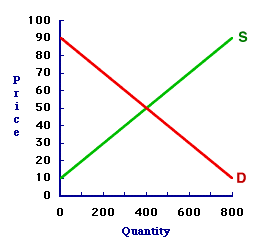
|
|
LIMITED RESOURCES: Finite quantities of labor, capital, land, and entrepreneurship available to an economy for the production of goods and services. This is one half of the fundamental problem of scarcity that has plagued humanity since the beginning of time. The other half of the scarcity problem is unlimited wants and needs.
Visit the GLOSS*arama
|
|


|

|
                           EQUILIBRIUM QUANTITY: The quantity that exists when a market is in equilibrium. Equilibrium quantity is simultaneously equal to both the quantity demanded and quantity supplied. In a market graph, the equilibrium quantity is found at the intersection of the demand curve and the supply curve. Equilibrium quantity is one of two equilibrium variables. The other is equilibrium price. Equilibrium quantity is the quantity exchanged when a market is in balance. Because quantity demanded and quantity supplied are equal, there is no shortage nor surplus in the market, which means that neither buyers nor sellers are inclined to change the price or the quantity, which is an essential condition for equilibrium.The MarketThe market model',500,400)">model displayed in the exhibit here can be used to identify the equilibrium quantity. This particular model represents the market for 8-track tapes, which are filled with the works of classic performers such as The Carpenters and Englebert Humperdink. The buyers and sellers happen to be folks attending the 88th Annual Trackmania 8-Track Tape Collectors Convention at the Shady Valley Exposition Center.| Equilibrium Quantity | 
|
Before getting to the equilibrium quantity consider the market itself. - First, the demand curve (D) is negatively sloped--higher prices correspond with smaller quantities. This negative slope indicates the law of demand.
- Second, the supply curve (S) is positively sloped--higher prices correspond with large quantities. This positive slope indicates the law of supply.
Clearing the MarketEquilibrium quantity results when the market is in balance, which is equality between quantity demanded and quantity supplied. The market is clear of any shortage or surplus. The only quantity that accomplishes this task is at the intersection of the demand curve and supply curve. This intersection point, and the quantity that results, can be identified by clicking the [Equilibrium Quantity] button in the exhibit.Doing so reveals that the equilibrium quantity is 400 tapes. At this quantity, the demand curve and supply curve intersect. The quantity demanded is 400 tapes and the quantity supplied is 400 tapes. The quantity demanded is equal to the quantity supplied. The buyers can buy all that they want, so there is no shortage. The sellers can sell all that they want, so there is no surplus. Neither buyers nor sellers are motivated to change the price. The forces of demand and supply are in balance. This is the ONLY quantity that has a balance between these two quantities. Best of all, because this is equilibrium, the equilibrium quantity of 400 tapes does not change and the equilibrium price of 50 cents does not change unless or until an external force intervenes.

Recommended Citation:EQUILIBRIUM QUANTITY, AmosWEB Encyclonomic WEB*pedia, http://www.AmosWEB.com, AmosWEB LLC, 2000-2025. [Accessed: July 18, 2025].
Check Out These Related Terms... | | | | | | | | | |
Or For A Little Background... | | | | | | | | | | | | |
And For Further Study... | | | | | | | | | | | | | | |
Search Again?
Back to the WEB*pedia
|



|

|
BROWN PRAGMATOX
[What's This?]
Today, you are likely to spend a great deal of time browsing through a long list of dot com websites seeking to buy either a case of blank recordable DVDs or a pair of red goulashes with shiny buckles. Be on the lookout for mail order catalogs with hidden messages.
Your Complete Scope
This isn't me! What am I?
|

|
|
General Electric is the only stock from the original 1896 Dow Jones Industrial Average remaining in the current index.
|

|
|
"A winner is someone who recognizes his God-given talents, works his tail off to develop them into skills, and uses those skills to accomplish his goals. " -- Larry Bird, basketball player
|

|
NABB
National Association of Business Brokers
|

|
|
Tell us what you think about AmosWEB. Like what you see? Have suggestions for improvements? Let us know. Click the User Feedback link.
User Feedback
|


|


